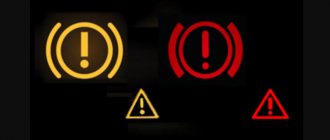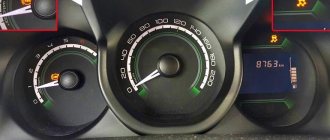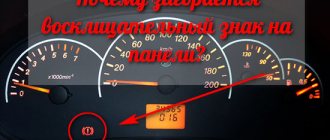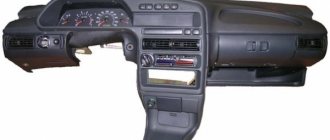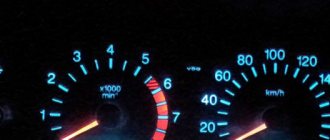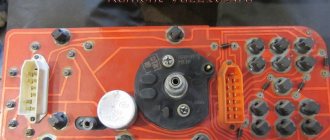What does it mean
This sign informs the driver that the brake fluid level is low. If it is detected on the panel, it is recommended to immediately stop and check the brake fluid level in the reservoir. It must be no lower than the MIN mark; otherwise, it is recommended to top up the fuel fluid and check the brake line for fluid leaks.
TJ has good fluidity and is able to seep where water will not leak. Continuing to drive with leaking brake fluid is unsafe and PROHIBITED!
During normal operation of all elements of the car, the indicator lamps light up when the ignition is turned on; as soon as the engine starts, all indicators should go out.
conclusions
Please note that replacing brake fluid is also necessary because, over time, it accumulates water particles from the air and becomes less effective.
With the development of the automotive industry, more modern instrument panels (DP) began to be used in vehicles. The software is used to inform the driver about the basic parameters of engine operation, as well as to warn about possible malfunctions in the operation of systems and components. What does the exclamation mark and other indicators mean? A description of the main icons is given below.
Reasons for low level
A low brake fluid level may occur due to a brake fluid leak. It is necessary to check the entire brake system for leaks; if any are found, fix them immediately.
It should also be noted that low fluid levels can be observed due to worn brake pads. This is explained by the fact that the thickness of the pad becomes smaller and the caliper piston extends further, therefore, the fluid level in the reservoir decreases. After replacing the pads, the level will be restored to its original position.
If the pads in your car are worn out, you can read how to replace them yourself here.
Non-mechanical reasons for the indicator to turn on
If everything is in order with the car, there are no leaks and the pads are normal, then most likely the reason is in the electrical wiring or the brake fluid level sensor.
To check the functionality of the sensor, you need to unscrew it and forcefully lift the sensor ring up. If the lamp does not go out, then there is a breakdown in the sensor.
Checking the electrical wiring of the sensor is carried out by closing its contacts on the connector. We take out the chip from the brake fluid level sensor and insert a jumper into it; if the lamp lights up, then the electrical wiring is intact.
After reading this article, you can easily figure out the reason for the low brake fluid level indicator to light up and localize the problem.
☺Blinking exclamation mark when moving ((!))☺
Hi all!
I was driving to work one day and suddenly noticed that an exclamation mark ((!)) was flashing on the dashboard. It flashed when accelerating and braking. I was a little scared, I had never encountered anything like this, I thought it was something serious. At the same time, the car behaved the same as always, nothing had changed. Arriving home, I immediately went to the website and realized that this problem was related to the brake system, and that’s not something to joke about!
There was a lot of crazy advice, like lower the handbrake, etc. This made me smile, of course, but the issue had to be resolved. After reading several articles and posts on the Internet, I discovered several reasons for the flashing exclamation mark, namely: 1) The brake fluid level is close to the minimum and when accelerating, the brake fluid rushes to the rear wall and vice versa when braking. 2) Problem with the float in the brake fluid barrel. 3) Excessive wear of the brake pads.
First of all, I opened the hood and saw that the brake fluid was at the minimum level. I just went, bought brake fluid and topped it up to the maximum. The problem completely disappeared, so there was nothing wrong with it.
I noticed a lot of questions about the compatibility of brake fluids, is it possible to mix them? For this reason, I decided to add an answer to this question here.
Is it possible to mix brake fluid from different manufacturers?
Brake fluids, like motor oils in principle, have come a long way in evolution. Now there are many varieties (there will be a separate article about this, in which you can read what DOT means). But the most common types according to the DOT standard are:
DOT 3 – used in low-speed vehicles.
DOT 4 – used in modern high-speed cars.
DOT 5 – used in high-speed sports cars.
All of these fluids are different and made for completely different thermal loads and for different brake pressure systems. In order for you to understand a little, I will say that DOT 3 brake fluids have a much lower boiling point than, say, DOT 4 or DOT 5. That is, DOT 3 will boil at a temperature of 150 degrees Celsius, but DOT 4 and DOT 5 will boil at 200 – 230 degrees Celsius. Therefore, DOT 3 is used in low-speed vehicles, usually in trucks with drum brakes. Drum brakes heat up less when braking than disc brakes.
The composition of liquids is also different. Nowadays, liquids are divided into mineral, glycol and silicone.
Now the most interesting part of the article is - is it possible to mix them?
The manufacturers themselves explain that mineral brake fluids should not be mixed with glycol ones. Otherwise, the rubber cuffs of the hydraulic drive units may be damaged, and clots may also fall out in the liquid.
Modern brake fluids are mostly glycol (be it DOT3, DOT4, DOT5), mostly replaceable. Again from the words of the manufacturers themselves. You can mix them, but as the manufacturer himself assures, this should only be done in emergency situations. If you mix DOT3 and DOT4 brake fluids, or DOT4 and DOT5, the performance of the final fluid will decrease. The thing is that glycol fluids are hygroscopic (absorb moisture), and after a certain period of time they need to be changed. So, as I already wrote above, DOT3 will boil earlier than DOT4, and if you mix liquids, your boiling point will drop, and significantly.
RESULT. If you need to mix brake fluid in an emergency, damage to the brake system. Then you can mix DOT3 and DOT4 and DOT5. But if your brake system level has simply dropped, then you need to add brake fluid of its class, that is, if you have DOT4 in it, then you need to fill it with DOT4, no matter what manufacturer, almost all manufacturers make interchangeable fluids.
☺THANK YOU! GOOD AND GOOD ROADS TO ALL!☺
Source
What to do if the lamp comes on?
- The first thing you need to do is check the fuel fluid level. This is done simply and without any difficulties. Open the hood and look at the level, it should be between o and “MAX”. The level must be monitored constantly; for those who forget to do this, there is an exclamation mark. It lights up based on a signal from the sensor, which signals when the fuel level is below the permissible level.
By the way! There are often cases when the light comes on when driving over uneven surfaces and goes out as soon as the car drives onto a more or less level road. This happens precisely for the reason that the level of “brake fluid” is close to o and when the car is rocking, the sensor detects a low level and signals this to the instrument panel.
- If everything is in order with the brake fluid level, you need to check the fuel injection system, which is located in the brake fluid tank. I'll tell you how to do this now.
2.1. Turn on the ignition and make sure that the exclamation mark lamp comes on, that is, the indicator of insufficient fuel level. It should light up and go out if the level is normal and the sensor is working.
2.2. We turn off the power from the sensor and look at the lamp; if it goes out, most likely there is a problem with the sensor. Check the sensor, sometimes the problem is that the float fails and sinks to the bottom even though the fuel fluid level is fine.
2.3. If, after turning off the power from the sensor, the exclamation mark on the panel continues to light, most likely the problem is in the wiring, and the sensor itself is working. Perhaps the reason is a short circuit in the wiring, or something else, but one way or another the problem will be associated with a faulty wiring and a violation of its integrity.
If everything is fine with your fuel oil level sensor, but you want to check its operation, this is done quite simply
2.4. We press the rubber seal on the tank lid, so you lower the sensor float to the bottom, and in working sensors an exclamation mark on the panel lights up.
2.5. If the indicator does not light up, take a small piece of copper wire and turn off the power from the brake fluid level sensor. The prepared wire must be used to close the power contacts of the sensor, that is, the contacts on the wiring that is supplied to the sensor, and not the contacts of the sensor itself. With such a short circuit, a corresponding signal about low brake fluid level should appear on the panel. If this does not happen, most likely the sensor is working, and the problem is faulty wiring.
If the brake fluid level sensor is faulty, replace it; if the problem is in the float of this sensor, you can try to repair it; if the wiring is faulty, replace it or seek help from an experienced auto electrician.
Hi all! Today I want to raise a rather current topic that, judging by the questions on the forums and the number of requests in search engines, worries a large number of people. I want to talk about a phenomenon where when you press the brake pedal, an exclamation mark on the dashboard lights up.
I will try to give a comprehensive answer to this question and explain why this happens and what kind of damage may be involved. Go!
Let me start, perhaps, with the fact that if a lamp (!) lights up on the panel, it means something is wrong with the brake system. As a rule, this indicator signals a low level of brake fluid (BF) in the system. As you can imagine, faulty brakes are no joke and the problem needs to be addressed. I’ll say more, if anyone doesn’t know, OPERATING A CAR WITH A BURNING INDICATOR (!) IS PROHIBITED!
Since you don’t know what’s wrong and what caused this error to appear on the dashboard.
Why is the exclamation mark on the instrument panel of the Lada Priora and what to do?
If one of the lights lights up, then this, of course, indicates a breakdown. With the help of a certain icon, it is quite easy for experienced drivers to determine which automotive component needs repair. In the meantime, it is best for inexperienced car owners to familiarize themselves with each element located on the instrument panel in order to promptly eliminate the cause of the breakdown with their own hands. The information in this article and advice from professionals will help car owners familiarize themselves with the dashboard and understand why a particular light on the panel may light up.
In what cases is it necessary to remove the instrument panel?
Dismantling the Priora tidy is required for tuning or replacing burnt out lamps. The VAZ 2170 is a modern model, so there are not many fastenings on the panel. To disassemble you will need a set of screwdrivers. Don't forget to turn off the negative battery.
- The process begins with removing the mounting block. To do this, you need to turn the latches on the fuse cover and then remove it;
An exclamation mark lights up on the dashboard: what actions should car owners take?
Before you begin troubleshooting problems indicated by an exclamation mark that lights up on the instrument panel in a Priora, you should determine:
It is worth noting that if the above systems are working properly, the icons on the instrument panel will light up when the ignition system is turned on, but after a couple of seconds they should go out.
If the car owner sees that the light comes on while the engine is running, then first of all you need to check the functionality of the car's brake force distributor.
For what other reasons might the lights on the dashboard start to light up?
Taking into account the advice of experts, and in order not to harm one of the car systems, you need to check the functionality of electronic components. To do this, you will need to diagnose the electronic part, which is done quite easily - remove the dashboard and check the location of the terminals in the so-called sockets. And if the brake fluid level indicator lights up, then first of all the fluid level in a special tank is checked, and only after that new brake fluid is filled in to the recommended level.
Understanding why the light on the dashboard lights up and finding out what kind of breakdown this or that sign indicates is quite simple if you familiarize yourself with each element located on the instrument panel.
Source
What does it mean
This sign informs the driver that the brake fluid level is low. If it is detected on the panel, it is recommended to immediately stop and check the brake fluid level in the reservoir. It must be no lower than the MIN mark; otherwise, it is recommended to top up the fuel fluid and check the brake line for fluid leaks.
TJ has good fluidity and is able to seep where water will not leak. Continuing to drive with leaking brake fluid is unsafe and PROHIBITED!
During normal operation of all elements of the car, the indicator lamps light up when the ignition is turned on; as soon as the engine starts, all indicators should go out.
An exclamation mark lights up on the dashboard: what actions should car owners take?
Before you begin troubleshooting problems indicated by an exclamation mark that lights up on the instrument panel in a Priora, you should determine:
An icon can have multiple images:
It is worth noting that if the above systems are working properly, the icons on the instrument panel will light up when the ignition system is turned on, but after a couple of seconds they should go out.
If the car owner sees that the light comes on while the engine is running, then first of all you need to check the functionality of the car's brake force distributor.
Reasons for low level
A low brake fluid level may occur due to a brake fluid leak. It is necessary to check the entire brake system for leaks; if any are found, fix them immediately.
It should also be noted that low fluid levels can be observed due to worn brake pads. This is explained by the fact that the thickness of the pad becomes smaller and the caliper piston extends further, therefore, the fluid level in the reservoir decreases. After replacing the pads, the level will be restored to its original position.
If the pads in your car are worn out, you can read how to replace them yourself here.
Non-mechanical reasons for the indicator to turn on
If everything is in order with the car, there are no leaks and the pads are normal, then most likely the reason is in the electrical wiring or the brake fluid level sensor.
To check the functionality of the sensor, you need to unscrew it and forcefully lift the sensor ring up. If the lamp does not go out, then there is a breakdown in the sensor.
Checking the electrical wiring of the sensor is carried out by closing its contacts on the connector. We take out the chip from the brake fluid level sensor and insert a jumper into it; if the lamp lights up, then the electrical wiring is intact.
After reading this article, you can easily figure out the reason for the low brake fluid level indicator to light up and localize the problem.
What to do if the lamp comes on?
- The first thing you need to do is check the fuel fluid level. This is done simply and without any difficulties. Open the hood and look at the level, it should be between o and “MAX”. The level must be monitored constantly; for those who forget to do this, there is an exclamation mark. It lights up based on a signal from the sensor, which signals when the fuel level is below the permissible level.
By the way!
There are often cases when the light comes on when driving over uneven surfaces and goes out as soon as the car drives onto a more or less level road. This happens precisely for the reason that the level of “brake fluid” is close to o and when the car is rocking, the sensor detects a low level and signals this to the instrument panel.
- If everything is in order with the brake fluid level, you need to check the fuel injection system, which is located in the brake fluid tank. I'll tell you how to do this now.
2.1. Turn on the ignition and make sure that the exclamation mark lamp comes on, that is, the indicator of insufficient fuel level. It should light up and go out if the level is normal and the sensor is working.
2.2. We turn off the power from the sensor and look at the lamp; if it goes out, most likely there is a problem with the sensor. Check the sensor, sometimes the problem is that the float fails and sinks to the bottom even though the fuel fluid level is fine.
2.3. If, after turning off the power from the sensor, the exclamation mark on the panel continues to light, most likely the problem is in the wiring, and the sensor itself is working. Perhaps the reason is a short circuit in the wiring, or something else, but one way or another the problem will be associated with a faulty wiring and a violation of its integrity.
If everything is fine with your fuel oil level sensor, but you want to check its operation, this is done quite simply
2.4. We press the rubber seal on the tank lid, so you lower the sensor float to the bottom, and in working sensors an exclamation mark on the panel lights up.
2.5. If the indicator does not light up, take a small piece of copper wire and turn off the power from the brake fluid level sensor. The prepared wire must be used to close the power contacts of the sensor, that is, the contacts on the wiring that is supplied to the sensor, and not the contacts of the sensor itself. With such a short circuit, a corresponding signal about low brake fluid level should appear on the panel. If this does not happen, most likely the sensor is working, and the problem is faulty wiring.
. Asks
: Smirnov Sergey.
The essence of the question
: An exclamation mark lit up on the instrument panel of the VAZ-2112, I don’t understand why?
Good afternoon I sometimes get an exclamation mark in a circle on my dashboard, most often this happens when braking! Please tell me what could be the reason and how to solve it?
Why does the exclamation mark (!) light up on the instrument panel?
At the moment when the car brakes, the brake cylinders are pushed forward as much as possible, thereby acting on the pads. At this time, the cylinders are filled with the required amount of brake fluid in the system, and its level in the reservoir drops. It is for this reason that a similar exclamation mark lights up on the instrument panel, informing the driver about the minimum level of brake fluid in the reservoir, and accordingly in the system as a whole.
The following two tabs change content below.
Hard or soft brake pedal: what is the reason and what to do
All my life I have been surrounded by cars! First, in the village, already in the first grade, I was rushing around on a tractor through the fields, then there was JAVA, then a penny. Now I am a third-year student at the Polytechnic Faculty of Automotive Engineering. I work part-time as a car mechanic and help repair cars for all my friends.
Reasons for appearance
If such an indication occurs, first of all we check the sensor itself, which is located in the brake fluid reservoir. It is a float that actively interacts with the brake fluid.
When the float is dismantled, it must be put away on a rag.
In order to check its serviceability, it is necessary, with the engine running, remove it from the tank body and manually change the position of the float. If the indication on the instrument panel does not disappear and does not react in any way depending on the influence on it, then the sensor is faulty and needs to be replaced.
Where might brake fluid leak?
It is very easy to find out whether the required level of brake fluid is in the system, since it can be seen visually through the brake fluid reservoir. Its level should always be closer to o, and if it is significantly less, or its level has dropped, then a leak is possible.
Brake cylinder
The front brake cylinder is leaking
What to do when the oil pressure light blinks on a warm engine
As a rule, leaks most often occur on the rear drums due to their excessive overheating. It is not difficult to notice a leak on the cylinders, since in the case of the front cylinder, the leaks will be noticeable on the caliper, and on the rear, it can drip directly from the drum. Problems with these elements usually arise during the cold season.
Brake hoses
The brake hose has cracks.
It is also very easy to determine the presence of ruptures or cracks in brake hoses, since this is all visible to the naked eye. Most often, they crack at bends or due to friction with adjacent elements of the car body.
Master brake cylinder
Traces of brake fluid are clearly visible on the body.
When inspecting the brake master cylinder, inspect its external condition for visible leaks.
Location of the vacuum brake booster and master cylinder
If a leak occurs, brake fluid will drip onto the gearbox housing and then onto the CV joint on the left side. This is easy to notice, and only then proceed to replace it.
Electronic instrument cluster flash x4 for Lada Priora, Kalina, VAZ 2110-2112
Route service including:
- Statistics for the trip, current and previous day;
- Active warning system - on-board network, injection controller, low fuel level, critical engine temperature, parking brake, exceeding the set speed, possibility of ice; maintenance reminder system (oil change, filters, spark plugs, belts).
- A diagnostic service that allows, if there are errors, to obtain their decoding in expanded text form.
- View telemetry data.
- The software supports January 5.1/7.2, BOSCH M1.5.4, MP7.0 Euro II/III, MP7.9.7 Euro II/III, M73, M74.
- A visual service, when the user can choose what parameters he wants to see on the screen, plus the choice of display fonts, adjusting the brightness of groups of indicators.
- Autolight. The “Autolight” controller, produced by “Elekomm” as a separate product, is simply a function in the FLASH X4 instrument cluster!
- The software update system provides the ability to download new versions of the program without removing (dismounting) FLASH X4.
Purpose:
- Functional purpose: a control and diagnostic device for displaying vehicle operating parameters, diagnostics and service support.
- The following functions are implemented in the FLASH X4 CEP:
CEP "FLASH X4" processes information coming from:
Parameters measured by the CEP computer “FLASH X4”:
- Vehicle mileage (based on speed sensor). Sensor parameters: 6000 pulses. for 1 km. mileage;
- Fuel consumption per hour or per 100 km. (based on fuel consumption sensor). Signal parameters: 16000 pulses. for 1l. fuel;
- Time with discreteness of 1 sec. Accuracy is no worse than /- 2 sec., per day;
- Voltage in the vehicle's on-board network with an accuracy of 0.1V unit of the least significant digit in the range of 0-24 V;
- External temperature using external temperature sensor 2115-382810 VDO (TU 4573-003-43820854-98);
- Remaining fuel in the tank (using the standard fuel sensor).
Specifications:
- Operating supply voltage range: from 8 to 24 V.
- Current consumption in operating mode: from 0.25 to 2 A.
- Current consumption in parking mode: from 0 to 10 mA.
- Ambient temperature during storage: from -30 to 85 degrees. WITH.
- Ambient temperature during operation: from -20 to 70 degrees. WITH.
- Relative air humidity up to 90% at a temperature of 40°C.
- Supported interfaces: K-Line in accordance with ISO9141 and ISO14210J.
- Overall dimensions: no more than 130x130x360 mm.
- Weight (without accessories): no more than 1500 g.
Based on continuously received information, the CEP displays a large number of instantaneous and statistical parameters of vehicle movement in a user-friendly form.
The instrument cluster computer notifies the driver about malfunctions of the injection system and electrical equipment of the vehicle (on-board voltage exceeding permissible limits, errors in the engine management system controller, deviation from the required limits of the parameters of the input and output signals of the controller), and offers the user a map to find the fault that has arisen;
Based on data on the vehicle’s mileage and the calendar stored in the memory, it reminds you of the need for regular vehicle maintenance and issuing a list of mandatory work; allows the user to set parameters for various alerts depending on time, date, fuel remaining, current speed or vehicle mileage. Using a computer, you can view and adjust the parameters of the electronic engine control unit (ECU), as well as control the operation of individual components and mechanisms of the vehicle.
Controls: The only external control of the FLASH X4 CEC is the encoder. By turning the knob (without pressing), you can adjust the brightness of the backlight of the instrument cluster, as well as the heater and other devices, the brightness of which was previously adjusted using a standard regulator. Turning the encoder and pressing alternately changes the available screens. Double-clicking (with a short interval) on the encoder enters the user menu from the main menu. When entering this mode, the backlight brightness cannot be adjusted until you exit the menu.
Technical solutions:
A special feature of the FLASH X4 CEP, in contrast to standard devices for similar purposes, is its high functionality. The following is a description of specific technical solutions that the buyer should be aware of, showing the level of development.
- The coolant temperature indicator consists of 8 LEDs. The first 6 turn on with a green glow. The 7th LED is red. Turning on the 8th (also red) switches the 7th and 8th LEDs into flashing mode with a simultaneous sound signal.
- The fuel level indicator also consists of 8 LEDs. When the tank is full, they all have a green glow. If the level drop has reached the 2nd LED, the 1st and 2nd lights up red. If the level drop reaches the 1st LED, both (1st and 2nd) begin to blink, attracting the driver’s attention and reminding them of the need for urgent refueling.
- In addition to the external one, on the front panel of the FLASH X4 CEC, there is a window for a built-in photosensor. When the light level changes, based on the sensor signal, the level of illumination of the revolutions, speed, coolant temperature and fuel level indicators changes.
- The overspeed alarm built into the “FLASH X4” CEP operates as follows: In the “SETTINGS” menu, 2 speed alarm thresholds are set. When the speed reaches the first threshold, the “FLASH X4” indicator begins to flash, urging you to slow down. When the 2nd threshold is reached, the indicator switches to continuous lighting mode. If desired, the speed warning system can be disabled through the same menu section.
- The 7-segment tachometer indicator shows the value in the “0.75” format up to 1000 rpm, and when exceeded, turns off the least significant digit.
- The “DEMO” mode can be turned on either through the menu using the encoder, or by supplying 12V to both inputs of the direction indicators. In this case, the mode is switched on after 10 seconds, with the obligatory supply of power to the 12V-Battery and 12V-Ignition switch contacts.
- The user has the opportunity to turn on the backlight of the instrument cluster without turning on the side light switch. This can be done through the “SETTINGS” menu by checking the required line.
New Lada: Design features of the engine cooling system 21126 on the VAZ 2170 2171 2172 Lada Priora.
Enabling CEP. Main menu: When you turn on the ignition, a splash screen appears on the display with a picture of the car, software version number and date. After a short pause, you switch to the main menu.
In addition to the LED scales, the coolant temperature and remaining fuel are shown in numbers. Low coolant temperatures are shown as "?". Data that is outside the tolerances is also shown, which in many cases means a sensor break. The clock shows the current time in 24:00 format; Fuel consumption is shown when parked in liters per hour, and at speed > 0, in liters per 100 km. mileage;
Battery voltage – in volts and tenths of a volt; Daily mileage – in kilometers and hundreds of meters after the separator; Total mileage – in kilometers. Storage of information about total mileage is non-volatile.
Double-clicking (with a short interval) on the encoder transitions from the main menu to the user menu. If all the lines of the selected menu do not fit on the screen, a down arrow is displayed at the bottom, indicating that by rotating the encoder you can move through the menu below, calling up all possible functions. You can enter the “below” menu level by pressing the encoder once. Exit the submenu by moving the “highlighted” line to “exit menu” and pressing the encoder once. If you do not touch the encoder for 30 seconds, or turn off and then turn on the ignition, an automatic transition to the main menu will occur. To change digital parameters, you need to stand on the selected line and press the encoder once. An icon <...-> will appear in the upper right part of the screen, indicating the possibility of data collection.
Lights indicating a malfunction
Now let's look at the indicators that indicate problems.
| The red battery symbol lights up on the control panel if there is no battery charge from the generator unit. In the case of hybrid cars, the appearance of such a light will be accompanied by the inscription Main. |
| A lamp in the form of an oil can informs the driver that there is a lack of motor fluid in the power unit. The symbol always appears when the ignition is activated and disappears after the engine is started. If the indicator lights up after starting the internal combustion engine, then you need to check the oil level in the engine, all leaks must be eliminated. |
| Malfunction of the airbags. You need airbags; if an emergency or collision occurs, then most likely the airbags will not deploy. |
| This symbol can be made in different variations. If the color of its glow is red, then there are malfunctions in the functioning of the brake system, so the system must be checked before driving. The lamp may come on as a result of a lack of brake fluid in the reservoir or worn out pads. It is possible that the reason for the appearance of the lamp is due to a sensor failure. |
| The on-board computer detected malfunctions in the functioning of the ABS. If there is ice on the roads, then the problems must be corrected, since such driving can be very dangerous. The brake will function, but the ABS system will not work. |
| The Check Engine light comes on when the electronic control unit detects a malfunction in the operation of the power unit. There can be a huge number of reasons in this case, so you need to do computer diagnostics. |
| Faulty glow plugs - this symbol is only available in diesel vehicles. If the light is constantly on, you need to check the ignition system. |
If you are faced with a problem with the dashboard not working, then the video below will allow you to familiarize yourself with the repair process using the example of a Volkswagen car (the video was filmed by the altevaa TV channel).
Hello, the red exclamation mark in the triangle on the Priora, Priora '10, came on. ABS works properly
Information indicators
The lights on the dashboard can indicate failures in the operation of the engine and other systems, or be of an informational nature. In any case, the car owner must be able to decipher the “messages” transmitted by the control module in order to promptly fix the problem in the event of a breakdown. First, let's look at the description of information indicators.
| Icon | What does it mean |
| A yellow wrench in the background of the car indicates that the system has detected a malfunction in the engine. The EPC failure indicator may indicate problems with the sensors or controllers; sometimes the wrench icon appears when there is a malfunction in the electronic component of the transmission. Computer diagnostics of the car can tell you exactly what this error means. | |
| A red indicator in the form of a car with a lock usually lights up in the event of malfunctions in the operation of the anti-theft system, in particular, we are talking about a standard installation. In practice, such malfunctions are usually accompanied by the inability to start the power unit. If the indicator simply blinks when the car is locked and its security is activated, then there is no need to worry. | |
| The exclamation mark indicator can only appear in a car with a hybrid power unit; its appearance is due to problems with the operation of the electric drive device. When such an indicator appears, it is better to perform computer diagnostics - this option is the most relevant if you want to get accurate information about the breakdown. | |
| An icon in the form of a car with an open door may light up on the instrument panel if the ignition is turned on or the car engine is running and one of the doors is open. This can also apply to the trunk lid as well as the hood. If you checked the doors and are sure that they are all locked, then most likely the reason is inoperative limit switches that are installed on the doors or on the pillars between the door and the body. It may be that the electrical circuit connecting the limit switch is damaged. | |
| The ESP icon is a vehicle stability control sensor. The indicator may appear if the system has detected a slippery section of the road along which the car is moving. Activation of this unit is carried out to prevent wheel slipping by reducing the power of the power unit. In principle, the appearance of an icon does not threaten the car with anything bad, since the indicator itself is informational. However, if a yellow triangle, wrench or wear symbol lights up next to the light, then you need to worry about the performance of the system. | |
| The wrench symbol in yellow tells the driver that the vehicle is due for maintenance. You need to change the oil, check the filters, etc. When the maintenance is completed, the indicator can be reset by briefly disconnecting the battery terminals. |
Possible reasons
The exclamation point in the yellow triangle is lit
If your car has an anti-lock braking system (ABS), then normally the exclamation mark should light up when you lift the handbrake and start the engine. In cars without an ABS system, the exclamation mark light will only light up if there is a malfunction. If this sign lights up and does not go out while driving, this indicates a problem. So what could cause this sign to light up?
An exclamation point in a red or yellow circle indicates serious problems with the brake system.
Let's sum it up
As you can see, the exclamation mark (!) on the instrument panel is lit for various reasons. Taking into account the fact that on different cars such an indicator can light up in different colors (yellow or red), it is important to be able to accurately determine the cause.
In most cases, a similar red icon in a circle means that there are problems with the brake system. The yellow color may indicate wear on the brake pads, that is, the icon of this color is informational.
If the problem element is the wiring, it is necessary to tidy up the connectors and wires. Finally, we note that sometimes the instrument panel itself may fail. Given that there are a large number of different cars, universal recommendations for removing the dashboard yourself may not be enough.
In other words, if you do not have sufficient experience, we recommend that in such a situation you contact an experienced auto electrician, completely abandoning attempts to remove the car’s instrument panel yourself. Otherwise, you can break the fasteners, break the wiring, damage individual controls, etc.
Why does the “check engine” light on the instrument panel light up: the main reasons. What should a driver do if the check light is on in the car? Useful tips and tricks.
An engine error appeared, the check light came on: how to erase the error from the ECU memory. Available methods for resetting errors, reading and decoding engine errors.
Numbers and letters on the automatic transmission: designation of automatic transmission modes. What are the automatic transmission modes for, how and when to turn on the main and additional modes.
Why does the check light light up on the dashboard? Is it possible to continue driving a car if the check engine light is on? What should you check first?
What functions does the fuel pump relay perform, signs of breakdown. Where is the fuel pump relay installed, how to properly check the fuel pump relay.
What does tire marking mean, deciphering tire markings and symbols on the tire. Basic designations, additional designations, American markings.
Warning symbols on the visor
Now we suggest you familiarize yourself with the warning indicators on the tidy. Let's consider only the most common symbols (video published by Kirill Mukhin).
| A yellow steering wheel symbol indicates that the steering system needs to be adapted. If this indicator lights up red, then you should diagnose the performance of the amplifier, which can be electric or hydraulic. |
| The key sign in the background of the car usually flashes after the car has been armed. If the lamp is on without blinking, this indicates possible problems that have occurred in the operation of the system. Typically, the appearance of the symbol is due to the fact that the anti-theft system mechanism cannot read the tag from the key or that the installation has not turned on. |
| The handbrake icon is always on when the handbrake lever is raised, as well as when there is a malfunction, in particular, wear on the brake pads. Sometimes this symbol appears when it is necessary to add brake fluid to the expansion tank. If the pads are intact, the fluid level is normal, and the indicator lights up when the lever is released, then most likely you need to change the brake fluid level sensor; it is located in the fluid reservoir. |
| The yellow coolant symbol indicates the need to add consumables to the reservoir. The indicator may light up if the sensor or float in the expansion tank breaks down, and if it lights up red, then the power unit may have overheated. Before adding antifreeze, you need to eliminate the cause of its leak, and also make sure that the engine is not overheated. |
| The washer system symbol appears when there is insufficient washer fluid or water level in the tank; in some cases, the cause is a clogged level sensor. In more modern cars, the icon may appear if the fluid used does not match. |
| Traction control indicator. If the symbol lights up continuously after starting the engine, then there is apparently a problem with the system. The indicator itself may look different, it all depends on the car. |
| This is the catalyst icon; it usually lights up after the unit has been overheated. A related symptom is a lack of engine power. The cause of overheating may be poor throughput of the catalyst cells or problems with the ignition system. If the catalyst fails, the fuel consumption should also increase. |
| Such a lamp indicates that a problem has occurred in the exhaust gas purification system. In practice, this light most often appears after the car has been filled with low-quality fuel. The reason may also be due to the inoperability of the lambda probe. |
Photo gallery “Dashboards of different cars”
1. Tuned PP in VAZ 2109 2. Tidy for Volkswagen Golf 3. Tidy for Renault Logan 4. Control panel for Toyota Camry
Dashboard indicator symbols
When starting up, almost all the icons on the dashboard light up - this way the operation of the light bulbs is checked. Some drivers believe that these are messages about malfunctions of some Lada Priora systems.
| No. on the diagram | Indicator designations |
| 1 | Tachometer. The device measures the engine crankshaft frequency (revolutions per minute). If the arrow goes beyond the red value, it means that the Lada Priora engine is operating in a dangerous mode; |
| 2 | Brake force distributor indicator. Reports defects in the operation of this node; |
| 3 | Battery charge. If the lamp lights up while the engine is running, the battery is discharged; |
| 4 | Left turn signal. The sign flashes when there is an alarm or the left indicator is on; |
| 5 | Speedometer. The device reports the speed at which your Lada Priora is currently moving; |
| 6 | Emergency lubricant pressure in the engine. If the sign lights up during operation of the power plant, it means the pressure in the system is low; it is highly not recommended to operate the engine in this condition; |
| 7 | Right turn signal (see No. 4); |
| 8 | Handbrake indicator. Lights up yellow if the Lada Priora is in the handbrake; |
| 9 | Antifreeze temperature in the cooling system. The operating temperature of the motor starts from 90° and above to the red mark. If overheating occurs, turn off the engine; |
| 10 | Gasoline level in the tank. If the fuel level approaches the minimum, the fuel pump may break; |
| 11 | Reserve gasoline level. The indicator lights up when there are less than 10 liters left; |
| 12 | Key for resetting the daily mileage and switching between display modes; |
| 13 | Alarm. If you have triggered the emergency lights, the lamp will flash along with the turn signal arrows; |
| 14 | Malfunctions in the electric amplifier. If defects appear in the EUR, the lamp will light up while the engine is running; |
| 15 | High beam designation. An active indicator indicates that you have switched to distant; |
| 16 | Outdoor Lighting. The system notifies the driver about the operation of the headlights or low beams; |
| 17 | Airbag malfunctions. If the lamp lights up after starting, then there is a high probability that the airbags will not deploy in a collision; |
| 18 | Immobilizer. An audible signal and flashing indicate that the immobilizer system is faulty; |
| 19 | Computer screen. Here you can view information from the bookmaker, as well as find out the total and daily mileage; |
| 20 | Indication of unfastened seat belts. The buzzer will signal a violation for 90 seconds; |
| 21 | The brake system is in disrepair. Most often these are worn pads or insufficient fluid in the system; |
| 22 | Disabling a specific airbag; |
| 23 | Indicator of defects in ASB operation, the braking system is operating normally; |
| 24 | Check Engine – there is a breakdown in the engines; diagnostics and subsequent repairs are urgently required. |

